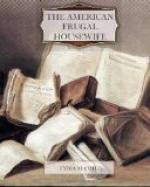Saffron, steeped in earthen and strained, colors a fine straw color. It makes a delicate or deep shade according to the strength of the tea. The dry outside skins of onions, steeped in scalding water and strained, color a yellow very much like ‘bird of paradise’ color. Peach leaves, or bark scraped from the barberry bush, colors a common bright yellow. In all these cases, a little piece of alum does no harm, and may help to fix the color. Ribbons, gauze handkerchiefs, &c. are colored well in this way, especially if they be stiffened by a bit of gum-Arabic, dropped in while the stuff is steeping.
The purple paper, which comes on loaf sugar, boiled in cider, or vinegar, with a small bit of alum, makes a fine purple slate color. Done in iron.
White maple bark makes a good light-brown slate color. This should be boiled in water, set with alum. The color is reckoned better when boiled in brass, instead of iron.
The purple slate and the brown slate are suitable colors for stockings; and it is an economical plan, after they have been mended and cut down, so that they will no longer look decent, to color old stockings, and make them up for children.
A pailful of lye, with a piece of copperas half as big as a hen’s egg boiled in it, will color a fine nankin color, which will never wash out. This is very useful for the linings of bed-quilts, comforters, &c. Old faded gowns, colored in this way, may be made into good petticoats. Cheap cotton cloth may be colored to advantage for petticoats, and pelisses for little girls.
A very beautiful nankin color may likewise be obtained from birch-bark, set with alum. The bark should be covered with water, and boiled thoroughly in brass or tin. A bit of alum half as big as a hen’s egg is sufficient. If copperas be used instead of alum, slate color will be produced.
Tea-grounds boiled in iron, and set with copperas, make a very good slate color.
Log-wood and cider, in iron, set with copperas, makes a good black. Rusty nails, or any rusty iron, boiled in vinegar, with a small bit of copperas, makes a good black,—black ink-powder done in the same way answers the same purpose.
* * * * *
MEAT CORNED, OR SALTED, HAMS, &C.
When you merely want to corn meat, you have nothing to do but to rub in salt plentifully, and let it set in the cellar a day or two. If you have provided more meat than you can use while it is good, it is well to corn it in season to save it. In summer, it will not keep well more than a day and a half; if you are compelled to keep it longer, be sure and rub in more salt, and keep it carefully covered from cellar-flies. In winter, there is no difficulty in keeping a piece of corned beef a fortnight or more. Some people corn meat by throwing it into their beef barrel for a few days; but this method does not make it so sweet. A little salt-petre rubbed in before you apply the common salt, makes the meat tender; but in summer it is not well to use it, because it prevents the other salt from impregnating; and the meat does not keep as well.




